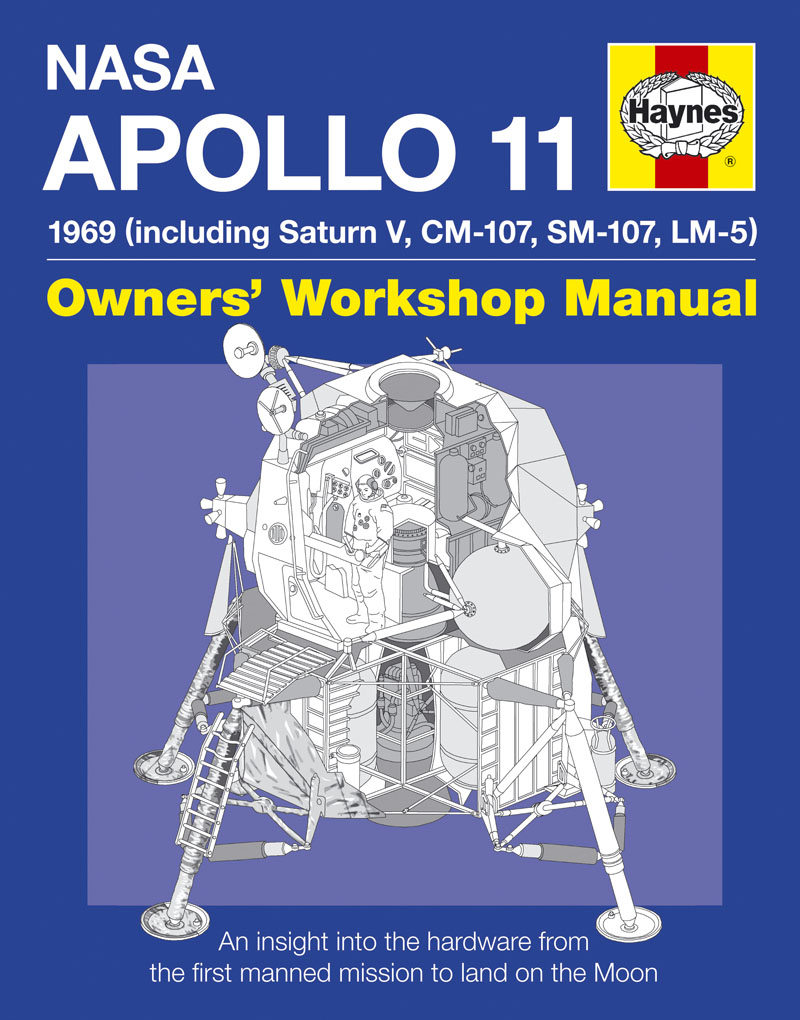A short clip from Double Take, a film by media artist Johan Grimonprez (there are a handful of other clips on YouTube). “They say that if you meet your double, you should kill him.” Hitchcock versus Hitchcock versus the Cold War, with cinematic history folding in on itself. There’s a worthwhile interview with Grimonprez over on the Cinema Scope website with more info.
Tag: history
-
Johan Grimonprez’s Double Take
-
NASA Apollo 11 Haynes Owners’ Manual

In honor of the 40th anniversary of the Apollo 11 moon landing, Haynes (maker of popular do-it-yourself auto repair manuals) has published an “owner’s manual” for the various craft involved in the Apollo 11 mission. Includes information on the Saturn V rocket, the Command/Service module (the part that astronaut Michael Collins was stuck in while Neil Armstrong and Buzz Aldrin got to go play on the moon), and the Lunar module. If you want to get me something retroactively for my 10th birthday, I think this would be it. (Via El Reg)
-
An Italian vision of a scientific Utopia
The science journal Nature reviews the new book Inventing Futurism: The Art and Politics of Artificial Optimism by Christine Poggi. The review itself is a decent synopsis of the Futurist movement in art and literature and the role that modern technology played in shaping European political thought in the early 20th Century. (Note: the Italian Futurist utopian dream devolved rapidly into the very frightening march of fascism, and would eventually become our model for Blade Runner-style sci-fi dystopia…not something to idealize, but worth learning a lesson from)
The Futurists imagined a world governed by electricity. Their electrical fantasies, writes Poggi, take a Utopian turn in their vision and evolve into an orgy of violence. They saw Italy as being “fertilized” by electricity, banishing hunger, poverty, disease and work. Air temperature and ventilation would be controlled automatically, telephones would be wireless, and crops and forests would spring up at speed. But in this world of ease and plenty, fierce competition would arise over superabundant industrial production. War would break out, fought by “small mechanics” whose flesh resembled steel. Deploying “steel elephants” and battery-powered trains from afar, they would wage a thrilling interplanetary war.
-
Vintage 3D Stop Motion Film of a Car Being Assembled
(video no longer available)
A vintage 3D stop motion film of a car being assembled, produced by Chrysler Motors (despite YouTube title, I think this is from later than 1939, when it was re-filmed in Technicolor). The springs must have been a pain to animate. Fun stuff! (via BoingBoing)
-
Krazy Kat Cartoon with Restored Soundtrack
For possibly the first time in 80 years this Krazy Kat cartoon, Ratskin, has been reunited with its original soundtrack recording, discovered on a rare Vitaphone disc in Australia. Found via Cartoon Brew, who has a good writeup of the discovery.
(note for George Herriman fans: the animated escapades of Krazy generally have little to do with the comic strip, more closely resembling Oswald the Lucky Rabbit or Felix the Cat’s hijinx)
-
A Brief Explanation of a Three Rotor Enigma Machine
A brief explanation of a three-rotor Enigma machine, the cryptographic device used by Nazi Germany during WWII to encode their communications. While the encryption technology had some flaws, it was largely broken by the Allies due to human mistakes made by the operators (not disposing of their key tables, writing down portions of the codes, captured hardware, etc).
-
Cartoon-y 19th Century Fukuoka Woodblock

I love Edo-era art and cartooning. Hard to imagine doing this with a woodblock! Image found on the always-great BibliOdyssey, also available on Flickr.
-
Étienne-Jules Marey
Pioneer of medical instruments, photography, and cinema. Took some very interesting early photographs in his research of animal locomotion and physionomy, which led to his successor Muybridge’s famous collections of plates.
-
Back in Boom Sic of 1999 There Were Rumors That
Back in boom [sic] of 1999, there were rumors that a Vegas/Vegas hotel was to be built. The entire Strip would be condensed to 5/8 scale, like Disneyland’s Main Street at 7/8 scale; or to copy the very popular Universal Citywalk, that five years earlier had launched the next stage of the Electronic Baroque in L.A. Norman M. Klein, in The Electronic Baroque: 1955-2050. From The Vatican to Vegas, 2004 p342.
-
Museums Would Map the Transition Toward This New
Museums would map the transition toward this new Baroque, like the new Guggenheims in Las Vegas, as part of a franchise that has stopped growing in the U.S. Museums were also under the gun. Very likely, shows will look more like Baroque wunderkammers than they used to. They will overlap and sprawl more, like browsers and search engines. The pressures to make shows monumentalize the new power relations will be intense, an often under shrinking curatorial budges, with signature buildings outside, like the Electronic Baroque: gaudy outside, conservative at its core. Norman M. Klein, in The Electronic Baroque: 1955-2050. From The Vatican to Vegas, 2004 p338.
